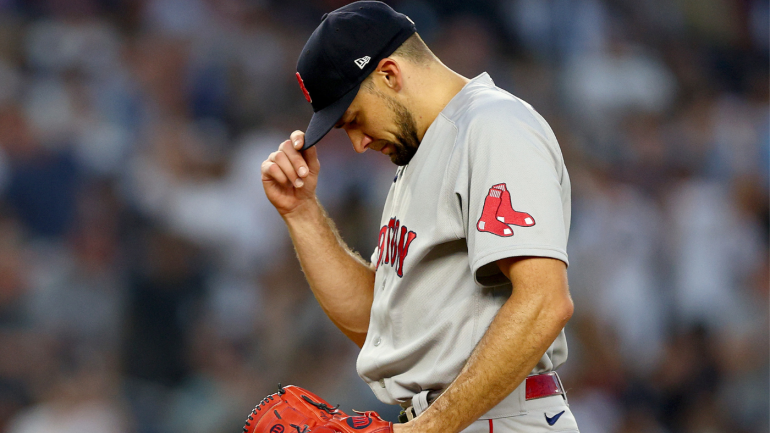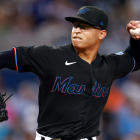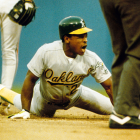
Free-agent right-hander Nathan Eovaldi signed a two-year pact worth at least $34 million with the Texas Rangers on Tuesday night. The deal includes a vesting player option for 2025 that could earn Eovaldi a maximum of $63 million over three seasons. While it's to be determined if Eovaldi can clear the necessary thresholds to trigger that option, one thing is for certain: his departure highlights yet another by the Chaim Bloom-led Boston Red Sox.
The Competitive Balance Tax, or Major League Baseball's version of a luxury tax, is often referenced only in relation to the penalties incurred with runaway spending. There are other components to the CBT that come into play on occasion, including as it relates to these Red Sox and the draft-pick compensation they'll receive in return for Eovaldi and Xander Bogaerts (who signed with the San Diego Padres earlier this winter) leaving as free agents.
If the Red Sox had got under the luxury tax at the deadline, they would have received picks 70 & 71 in the 2023 Draft for Bogaerts & Eovaldi. Instead they will receive picks 133 & 134. They also miss out on ~$1 million in additional bonus pool money going off 2022 slot values.
— Ian Cundall (@IanCundall) December 27, 2022
You see, the Red Sox finished last season with a tax payroll that was more than $4 million above the threshold, per the Associated Press. As Ian Cundall of Sox Prospects noted on Tuesday night, the Red Sox cost themselves significantly in next summer's draft by not ducking under the tax line. Instead of receiving picks No. 70 and 71, they've gained picks No. 133 and 134. That's a difference of essentially two whole rounds, assuming the standard 30 picks per. Accordingly, their signing bonus pool will be about $1 million smaller.
Now, these things are more complicated than looking at a spreadsheet after the fact and writing "the Red Sox should have traded so and so." There are real-world dynamics at play. With that in mind, let's revisit where the Red Sox were entering Aug. 2, the day of the 2022 MLB trade deadline.
The Red Sox came into that day with a 53-52 record, putting them just over the .500 threshold. They were 17 games behind the American League East-leading New York Yankees, but the installation of a third wild-card spot gave Boston hope. Indeed, the Red Sox trailed the Tampa Bay Rays (the final wild-card team both at the time and at season's end) by just two games. Additionally, they were a game behind the Cleveland Guardians and a half-game back of the Baltimore Orioles, complicating a potential postseason run.
Was it reasonable to think the Red Sox would make a run? It depends on one's perspective. Boston had won 92 games the prior season, and had reached the AL Championship Series, where they lost to the Houston Astros. Even so, the Red Sox had not played like a top team through the season's first four months. Their Pythagorean record entering Aug. 2, that is their projected record based on runs scored and runs allowed, ranked as the 11th best in the AL.
Whatever you made of the Red Sox's chances, it's not like they sat out the deadline. Bloom completed four moves over the final 48 hours:
- Traded LHP Jake Diekman to the White Sox for C Reese McGuire and RHP Taylor Broadway;
- Traded INF Nicholas Northcut to the Reds for OF Tommy Pham;
- Traded C Christian Vázquez to the Astros for OF Wilyer Abreu and INF Enmanuel Valdez;
- Traded LHP Jay Groome to the Padres for 1B Eric Hosmer, INF Max Ferguson, OF Corey Rosier, and cash.
The Red Sox tried to skin the cat, technically adding more big-league players (three) than they traded away (two) while swapping out a lefty reliever and their starting catcher for a backstop with more team control and adding a rental outfielder. (Hosmer, recently released, also proved to be a rental, albeit a paid-down one.) You wouldn't call this a seller's deadline, but it wasn't a true buyer's deadline, either. It was a little of both, and it would come to be a lot of nothing for the Red Sox's chances of making it to October.
Indeed, the benefit of hindsight allows us to write that it wasn't enough. The Red Sox went 26-32 after the deadline, finishing eight games back of the Rays. Had Bloom known that his team would falter the rest of the way, missing the postseason by a fair margin, would he have been able to pivot and duck underneath the tax line in an easy manner? Our answer is yes.
Even ignoring the possibility of trading Bogaerts or Eovaldi, there were other veterans Bloom could have moved to shave Boston's CBT number. To wit, the Red Sox have seen designated hitter J.D. Martinez and starter Rich Hill each depart this winter. Had the Red Sox traded Hill and Wacha, they would've cut it close on ducking under. It didn't have to be that complicated, though, because trading Martinez would've done the trick.
There are philosophical arguments to be had about when teams should buy, when they should sell, and when they should concern themselves with the CBT. (Lord knows we've gotten on Bloom's case for past moves that prioritized the last part.) It's not always cut and dried. Oftentimes, a lot of variables go into the calculus, making it a tricky calculation. That's partially why these executives are so well-compensated, and partially why some of them are well-regarded.
Bloom was the latter when he took over the Red Sox. He's encountering a lot of turbulence these days, however, making it open season to nitpick his every move -- or, in this case, non-move. If nothing else, perhaps Red Sox fans can take solace in the idea that their team is still, on occasion, capable of focusing on the on-field product more so than the budget sheet. Go figure that it just so happens to have resulted in a series of decisions that will cost them next draft.


















